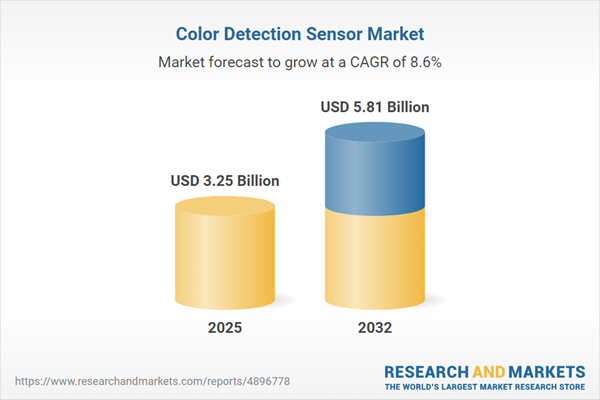Speak directly to the analyst to clarify any post sales queries you may have.
The color detection sensor market is rapidly evolving as industries embrace automation, advanced imaging, and digital transformation to elevate quality assurance and operational efficiency.
Market Snapshot: Color Detection Sensor Market Growth and Key Metrics
The Color Detection Sensor Market grew from USD 2.99 billion in 2024 to USD 3.25 billion in 2025. It is expected to continue growing at a CAGR of 8.64%, reaching USD 5.81 billion by 2032.
Scope & Segmentation of the Color Detection Sensor Market
This analysis offers a detailed outlook on the evolving color detection sensor landscape, with a focus on the following dimensions:
- Technology Types: Laser-based (scatter and triangulation), RGB sensors (2D and line scan cameras), spectrometers (benchtop and miniaturized), tristimulus (standard and extended range).
- Sensor Configurations: Contact (dip sensors, probe sensors); Non-contact (fiber optic, optical sensors).
- Wavelength Coverage: Infrared (far, mid, near), ultraviolet (UV-A, UV-B, UV-C), visible spectrum (400-450 nm, 450-700 nm).
- Application Areas: Automotive (ADAS, autonomous vehicles, infotainment), consumer electronics (smartphones, televisions, wearables), food & beverage quality inspection, industrial automation (assembly and process automation), medical diagnostics (blood analysis, imaging systems).
- End-User Sectors: Aerospace & defense (avionics, surveillance), agriculture (greenhouse, precision farming), consumer goods (apparel, home appliances), healthcare (clinical labs, hospitals), manufacturing (automotive and electronics manufacturing).
- Distribution Channels: Offline and online routes to market.
- Regional Markets: Americas (North America: United States, Canada, Mexico; Latin America: Brazil, Argentina, Chile, Colombia, Peru), Europe, Middle East & Africa (with key countries including UK, Germany, France, UAE, South Africa, Nigeria, others), and Asia-Pacific (China, India, Japan, Australia, South Korea, and selected Southeast Asian nations).
- Leading Companies: ams OSRAM AG, Broadcom Inc., Texas Instruments, ROHM, STMicroelectronics, Hamamatsu Photonics, Everlight Electronics, Vishay Intertechnology, Panasonic Corporation, SICK AG.
Key Takeaways for Decision-Makers
- Industrial automation and smart manufacturing are primary forces expanding the deployment of color detection sensors across production and inspection lines.
- Sensors capable of high-precision chromatic analysis are increasingly integral to predictive maintenance, waste reduction, and end-product differentiation in multiple industries.
- Advances in miniaturization and edge computing are fueling the integration of color detection capabilities into consumer electronics, portable diagnostic devices, and real-time process controls.
- Variations in regional regulatory environments shape the adoption rates and drive sensor customization to address sustainability and compliance requirements.
- Strategic supply chain readjustments, such as localizing component sourcing and redesigning logistics, help organizations manage changing trade dynamics and cost structures efficiently.
- Collaborative R&D and partnerships with technology leaders enable the development of tailored sensor solutions for niche market needs.
Tariff Impact on Supply Chains
Recent changes in United States tariff structures have prompted sensor manufacturers to reconsider their global sourcing and manufacturing strategies. Elevated duties on critical optical and semiconductor inputs have led to increased emphasis on partnerships with regional suppliers, backward integration, and portfolio optimization. These measures are aimed at stabilizing costs and delivery timelines while maintaining product performance standards in a shifting trade policy landscape.
Methodology & Data Sources
This report utilizes a combination of structured primary interviews with industry stakeholders and rigorous secondary research involving technical publications, regulatory documents, and patent filings. Data triangulation and expert validation ensure robust, actionable insights specific to the color detection sensor market.
Why This Report Matters for B2B Leaders
- Empowers businesses to identify emerging opportunities across technology, application, and geography—supporting informed R&D, sourcing, and go-to-market decisions.
- Equips decision-makers with a granular perspective on tariff-driven challenges, localization strategies, and innovation trends that impact both competitive positioning and investment planning.
Conclusion
Proactive adaptation to innovation, regulatory change, and shifting supply networks is essential for sustained growth in the color detection sensor market. This report offers a foundation for strategic initiatives that align with evolving industry and technology trends.
Additional Product Information:
- Purchase of this report includes 1 year online access with quarterly updates.
- This report can be updated on request. Please contact our Customer Experience team using the Ask a Question widget on our website.
Table of Contents
3. Executive Summary
4. Market Overview
7. Cumulative Impact of Artificial Intelligence 2025
Companies Mentioned
The companies profiled in this Color Detection Sensor market report include:- ams OSRAM AG
- Broadcom Inc.
- Texas Instruments Incorporated
- ROHM Co., Ltd.
- STMicroelectronics N.V.
- Hamamatsu Photonics K.K.
- Everlight Electronics Co., Ltd.
- Vishay Intertechnology, Inc.
- Panasonic Corporation
- SICK AG
Table Information
| Report Attribute | Details |
|---|---|
| No. of Pages | 185 |
| Published | November 2025 |
| Forecast Period | 2025 - 2032 |
| Estimated Market Value ( USD | $ 3.25 Billion |
| Forecasted Market Value ( USD | $ 5.81 Billion |
| Compound Annual Growth Rate | 8.6% |
| Regions Covered | Global |
| No. of Companies Mentioned | 11 |









